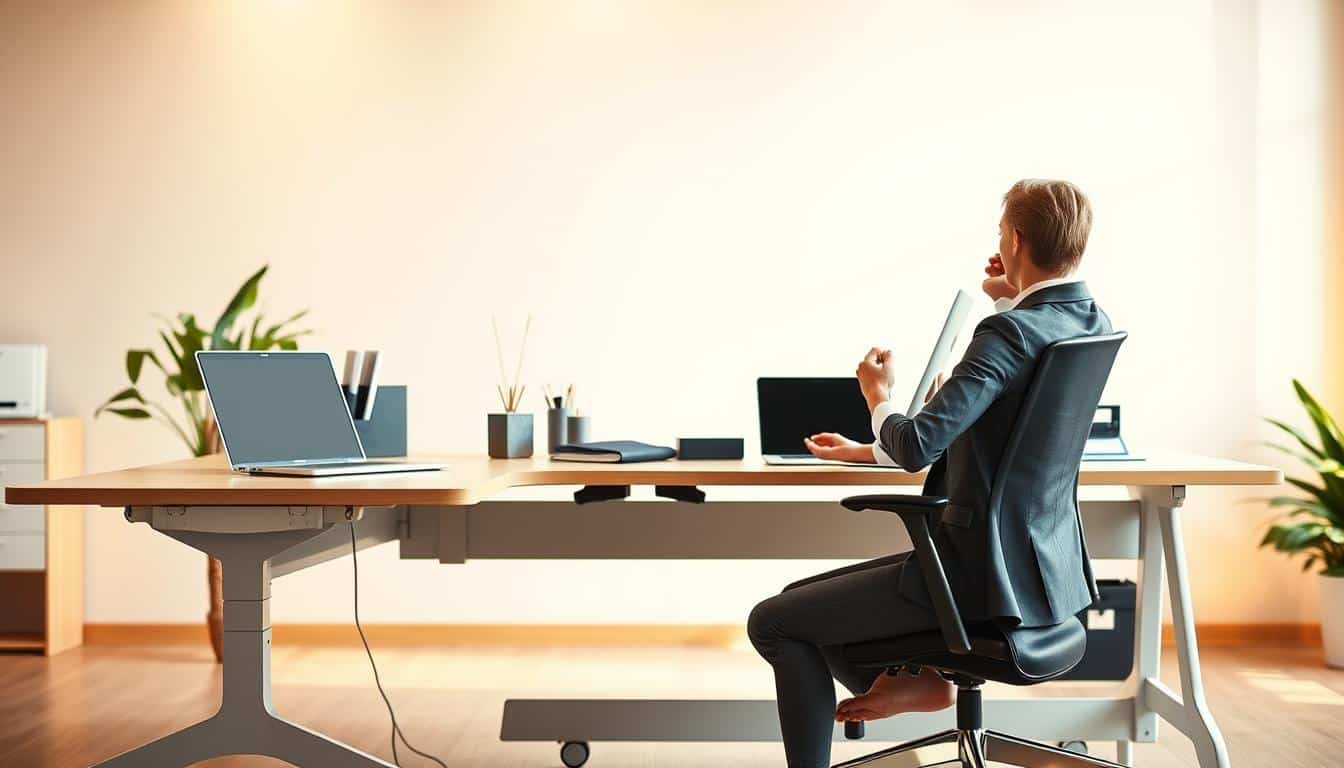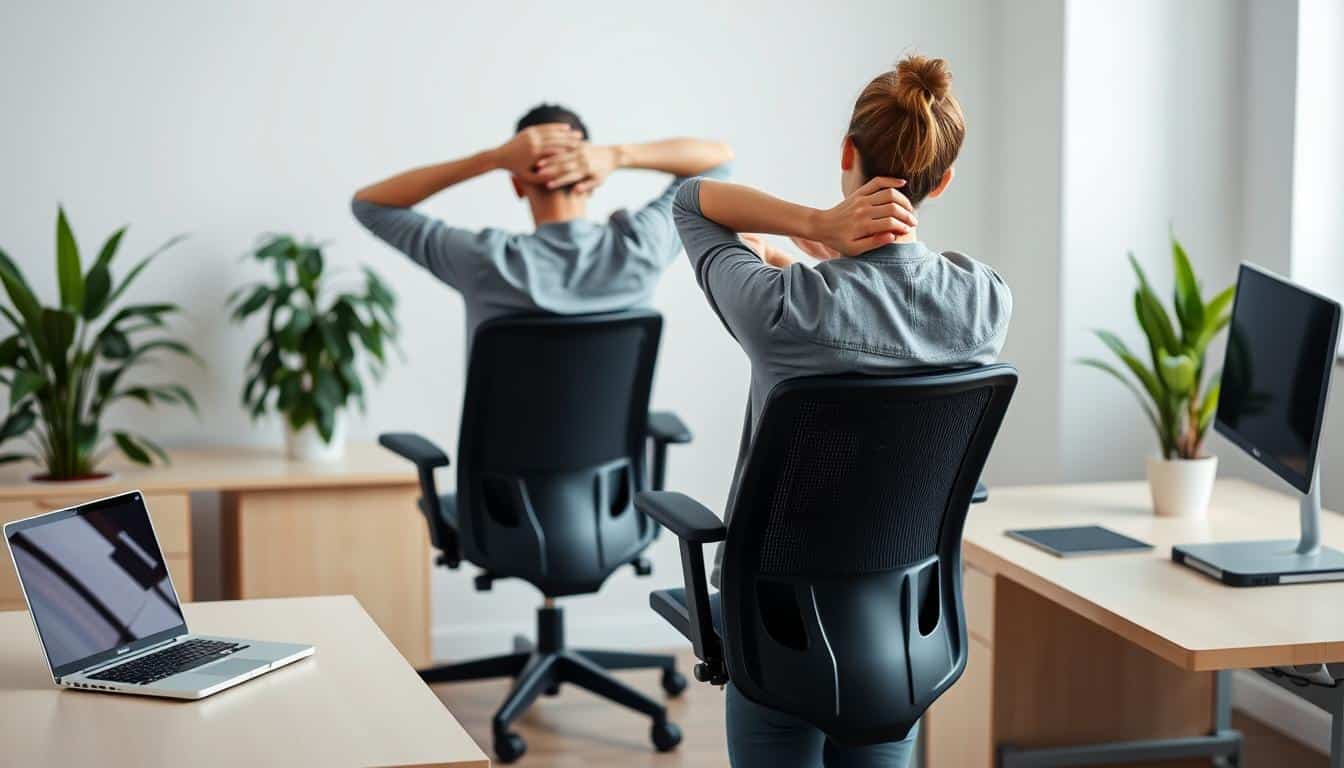In our busy work lives, more than 80% of us spend a lot of time sitting at our desks. This can cause many problems, such as discomfort and health issues. That’s why having a stretch routine for the office is so important. Doing simple stretches at work can help ease tension and make you more flexible. This lets you work better all day long.
Understanding the value of stretching is key. Taking regular breaks to move around is very important. By doing a desk stretch routine, you fight the bad effects of sitting too much. This can make your work area healthier and more comfy.
Introduction to Workplace Wellness
Promoting workplace wellness is key to a healthy office. Regular movement and ergonomic setups can make a big difference. An ergonomic office reduces strain and helps posture. This lowers the risk of chronic pain.
Adults often sit for about 6.5 hours daily at work. This lack of movement can cause health problems. It’s essential to take short breaks every hour. These breaks help you move and improve circulation and focus.
Stretching is also important for wellness at work. Doing simple stretches like wrist rotations and shoulder shrugs helps. They reduce tension and can make you more productive. Seated exercises are recommended to fight the effects of sitting too long.
Short, intense workouts can improve brain functions and memory. Having a focus on wellness boosts happiness at work. It also reduces sick days and improves team spirit.
Understanding the Importance of Stretching at Your Desk
Stretching is really important for those who sit a lot at desks. Sitting too much can cause health problems like muscle stiffness and less flexibility. Stretching helps fight off these bad effects.
Simple stretches at your desk can make a big difference. They improve how you sit and help prevent getting hurt. Studies even show that stretching breaks can boost blood flow, ease tight muscles, and make you more focused and productive.
Doing stretches regularly is not just good for work. It also helps your body stay flexible. For example, the Knee Kiss Pull helps your legs and blood flow. The Windmill stretch makes your back and legs more flexible, helping you sit better. Shoulder Rolls can ease shoulder tension and make moving easier, which is great for people who work at desks.
To really benefit, stretch major muscles two to three times a week. Start with a warm-up, hold each stretch for 30 seconds, and don’t bounce to stay safe. This routine can make you move better and reduce stiffness from sitting too much.
Benefits of a Desk Stretch Routine
Adding a desk stretch routine to your day can bring lots of perks. Simple stretches fight the bad effects of sitting too much. Studies say sitting long times is just as bad for you as smoking or being overweight. Being inactive for over eight hours ups health risks. So, moving regularly and stretching well is key to keeping tension at bay.
Doing stretches at your desk helps ease pain in your neck, back, and shoulders. These stretches make your posture better and you more flexible. This means you’ll enjoy work more. A study over 12 weeks showed workers who stretched for 10 minutes twice a week got better mentally and physically. Their work productivity went up too.
Some stretches fit right into other daily habits, like the 20-20-20 rule. This rule tells you to look away from screens every 20 minutes. It lowers eye strain and, with stretches, boosts wellness. Things like the Tush Cush make sitting right easier, adding to the benefit of stretching. Spending a tiny part of your day on this can make a big difference in work wellness.
Common Office-Related Ailments
Many office workers suffer from ailments because they sit too long and their workspaces aren’t set up right. These problems can really affect how much they get done and how good they feel. They often deal with neck pain, lower back pain, and shoulder strain.
Neck pain is very common in offices. It can range from a little discomfort to serious issues that need a chiropractor’s help. This pain usually comes from staying in one position too long or having a bad desk setup. Wrong setups can cause upper body tension. Lower back pain happens a lot too because people sit for too long. This leads to bad spine position and more pressure on the lower back. Carpal tunnel and headaches occur often as well, mainly from doing the same movements over and over without enough breaks.
Stretching a lot is key to fighting these office problems. It eases tension in the neck, shoulders, and back. Plus, it makes you more flexible and helps with blood flow. Introducing stretches when you’re at your desk can ease aches. It can also prevent problems from sitting too much. Research shows stretching can make your joints move better, reducing the risk of getting hurt.
Adding stretch breaks every 30 to 45 minutes at work is a great idea. It lessens tiredness and makes it easier to concentrate. This makes the office a healthier and more efficient place. Knowing about these typical office issues helps employees look after their health better. This way, they can be more comfortable at work.
Simple Desk Stretch Routine to Alleviate Tension
Adding some easy desk stretches to your day can really help lower tension. This will make you feel better and work better. Focus on stretching your arms, making your torso move more, and stretching your legs.
Stretching Out Your Arms
Arm stretches are key to easing shoulder tightness and making your upper body more flexible. Here are some stretches to try:
- Shoulder Stretch: Stand next to a wall with one shoulder close to it. Extend your arm up, then move it down behind you, like you’re following the hours on a clock.
- Wrist and Forearm Stretch: Stick one arm out with your palm facing up. Then, gently pull your fingers down and back. Do the same with the other hand.
- Overhead Stretch and Reach: This move stretches your chest and sides. Hold each stretch for 10-30 seconds on each side.
- Seated Cat and Cow: Do 8-10 of these to stretch your spine, neck, and shoulders.
Torso Stretch Techniques
Stretching your torso can take some pressure off your spine and make your posture better. Here are some stretches to include:
- Spinal Twist: Sit down, gently twist your torso to one side, and hold for 10-30 seconds. Then switch sides.
- Chair Twist: Sit sideways in your chair, grab the back of the chair, and twist to help release tension in your lower back.
- Neck Swings: Roll your head from one shoulder to the other, doing this 3-5 times.
- Head Tilts: Pull your head toward one shoulder and hold for 10-15 seconds. Then switch to the other side to ease neck and upper back tension.
Leg and Knee Stretches
Leg stretches are important for reducing discomfort from sitting too long. Here are some good stretches:
- Seated Hip Stretch: Cross one ankle over the knee of your other leg and lean forward. This helps with hip and glute tension. Hold it for 10-30 seconds on each side.
- Hip Flexor Stretch: Take a step back and bend your knees. Hold this stretch for 10-30 seconds on each side to help tight hip flexors.
- Hamstring Stretches: These stretches are good for your legs’ circulation. You can do them sitting or standing, holding for 10-30 seconds.
- Leg Swings: Stand and lightly swing your legs forward and back a few times to loosen up your hips.
How to Incorporate Desk Stretches into Your Workday
Adding desk stretches to your daily work can boost your health and work performance. Begin by setting up reminders on your phone or laptop. These reminders can let you know when it’s time to stretch for a minute or so.
Try stretching during meetings or between tasks. You can do stretches while sitting or standing to fit them into your busy day without neglecting your work. Simple moves, like stretching an arm across your chest or twisting your spine while seated, take only 30 seconds. Yet, they help relieve tight muscles effectively.
Make a plan to switch up your stretches through the day. Adding in different stretches, like lifting your heels off the ground or moving your wrists, helps target muscles that get sore from sitting too much. This keeps stretches easy to do and builds a positive environment for staying active at work.
Pick specific times to take short stretch breaks during your workday. You could stretch once in the morning, after lunch, and in the afternoon. These quick breaks are great for reducing muscle pain, boosting blood flow, and increasing energy.

By making stretching a regular part of your day, you are taking control of your well-being. Forming these habits changes your workplace into a space where health and efficiency are key.
Using Technology to Remind You to Stretch
Technology helps improve wellbeing at work by reminding us to stretch. Many apps are designed to encourage breaks and stretching during the workday. These tools boost physical activity and help you focus better.
Apps like Break Time let you set break times and get alerts to move. Move – Daily Activity to Stay Healthy offers stretches and reminders based on what you like. Stand Up! The Work Break Timer sends alerts for standing and moving. Meanwhile, StandApp combines reminders with stretching exercises.
For Android users, Randomly RemindMe provides custom reminders for stretching among other activities. Stretching Exercises – Flexibility Training offers guided stretching for more flexibility. Awareness tracks how much you move, urging you to take regular breaks. Mac users can use Healthier: Break Reminder for exercise reminders and Time Out for visual stretch prompts.
Windows folks have Big Stretch Reminder and EyeLeo to protect eyes and encourage stretching. Workrave offers customizable schedules with exercises, making stretching a daily habit.
Using tech for wellness makes the office better by making stretch reminders a key part of health. By using these apps, you improve your health and create a happier workplace culture.
Other Movement Strategies for Office Workers
Using smart movement strategies during work can boost fitness and fight the bad effects of sitting too much. Office workers can use different methods to feel better and healthier. Small changes in daily habits can lead to big improvements.
Here are some movement strategies to consider:
- Utilize standing desks to reduce sitting time and encourage a more dynamic work environment.
- Organize walking meetings to promote activity while discussing ideas, enabling collaboration in a moving atmosphere.
- Take the stairs instead of elevators for a quick cardiovascular boost.
- Incorporate stretching routines like the Cable Stretch or Shoulder Shrug to alleviate tension.
- Perform exercises such as the Hand Shake or Foot Rotation while seated to keep blood circulating.
Using these movement tips throughout the day helps prevent office-related health issues. Plus, it makes you physically and mentally healthier. Moving more can make work more productive and enjoyable too.
Conclusion
Adding stretches to your day at the desk is key for fighting the bad impacts of sitting too long. This summary shows the big health perks like better blood flow, less muscle tightness, and less pain. Doing stretches often improves your flexibility and energy, making the work vibe more lively.
Short breaks for stretching can really cut down on things like back pain and tired eyes, common in desk jobs. You can do many stretches even in a small space, showing how small efforts can make big changes. Keep up with these stretches to easily make them part of your workday.
Making health a priority with a good desk stretching routine leads to a more focused and effective team. The benefits of sticking to these simple exercises show how crucial wellness at work is for better work performance. Start stretching and see the big difference it makes in your office life.



